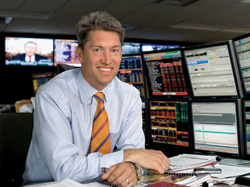The buyside is looking for even more insight and control over its algorithms.
That’s the viewpoint of at least one buysider, Mark Kuzminskas, director of trading at Robeco Investment Management who is searching for more information on how his algorithms operate and protection from them should one run amok. Vendors and the sellside are aware of these needs and trying to meet them.

Speaking at the 77th Security Traders Association of New York Annual Conference in New York Thursday, Kuzminskas described to attendees how Robeco uses algorithms and other electronic trading tools for 75 percent of its orders, but is increasingly unclear as to how the different algos slice up his orders, as well as route and select venues for them. This necessitates the need for more risk controls and transparency into how algorithms are designed and work, he added.
“After the AP tweet mishap, I rounded up my broker group and talked about having or insuring that we have risk control parameters around our algorithmic strategies so there is some level of protection for us,” Kuzminskas said. “It’s not like in the old days when you had a set of eyes watching each order-now we’ve got over 40 exchanges, dark pools, etc., and it’s difficult to watch your orders and know everything that is happening.”
Electronic trading now constitutes upwards of 75 percent of all equity volume traded, according to Tabb Group. This is up from 2005 when electronic trading was only 51 percent of all equity trading.
On Tuesday, a tweet from the Associated Press’ Twitter account erroneously stated that a bomb had exploded at the White House. But while hackers had sent the false tweet, algorithms automatically sent sell orders that caused a 143-point drop in the Dow Jones Industrial Average in less than a minute.
Aside from broker or vendor risk controls, another way that Robeco is trying to manage its algorithms is via pre-trade analysis. Kuzminskas said that his system looks at various algorithmic parameters, such as where orders are being executed, what the various rebate and fee structures are and how that affects his costs. By looking at these factors, he can then estimate what happens to his order before execution.
“Our orders go to so many various venues, trying to understand the routing strategy and the algo’s decision making process is complicated,” he said.
Paul Daley, head of product development at FOX River Execution Services, an algo provider, said that he hears the buyside’s cries for more transparency into how algos are designed and work. He told conference attendees that providing increasing transparency into electronic trading products and how they work is his greatest challenge.
“I spend much of my time explaining to the buyside how these algorithms work,” Daley said. “No algo is static. We are constantly adjusting them and talking with customers to give them a greater understanding of what algos do.”
The need for more control, risk protection and knowledge about algorithm decision-making will only continue at Robeco for as long as the firm continues to trade electronically, Kuzminskas said. And with the unrelenting rise of electronic trading, he expects to see his high-touch broker relationships as well as his program trading partnerships shrink.
“As we take more control over our actions and responsibilities with regards to algorithms and continue to trade electronically, it’s shifting the way we deal with the Street,” he said. “We feel more isolated on one hand as our broker list has shrunken over time. But on the other hand, this is enhancing our partnerships with the brokers we are working with.”



